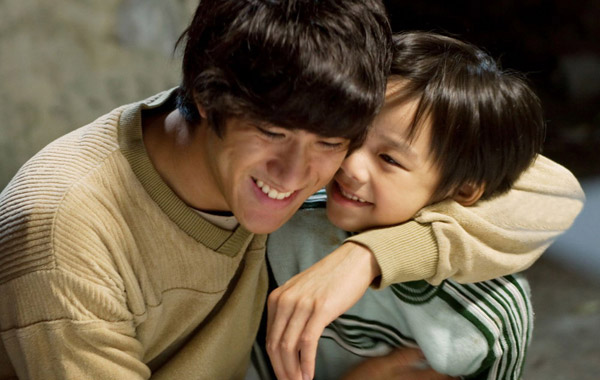Echoes of the Rainbow [Dir/Scr: Alex Law] (2010)
In the search for a distinct post-colonial identity, Hong Kong-ers, imbued with nostalgia, turn to architectural phenomena that showcase the transient journeys of their city from a bygone era. Amongst the ever-changing high skyline, fleeting moments are littered throughout the city, anachronistic cracks that show Hong Kong’s rich past and journey from a fishing village to an urban idyll.
A genre-based on this premise, “Nostalgia Cinema” has been prominent in the Hong Kong film scene since the 90s. A paradigmatic example is ‘Echoes of Rainbow,’ a winsome, elegiac tale of a family amongst the storefronts of the tong laus of Wing Lee Street. A beguiling bildungsroman, the film is filtered through the lens of the protagonist, young Chun-Yi, narrating the trials faced by his working-class family innocently. Using symbolism, turning points in the film and the fluctuations of life are mirrored by changes that happen in their surroundings, especially their living quarters whilst providing visceral depictions of life in the turbulent 1960s.
The film is set in ‘Tong Laus’, structures rooted in Hong Kong history. Following a series of historic events including the Second World War, Chinese revolution, Korean War etc, these buildings were built to provide housing for large numbers of refugees. Translating directly in English to “Chinese-style building, (Rajagopalan et al., 2012)” set amongst reflections of the colonized milieu, Echoes of the Rainbow becomes an honest portrayal of the distinct east-west culture of Hong Kong. Through linear story-telling of character journeys, Wing Lee Street is used to provide a symbol for the communal living culture in Hong Kong of the time. The lush cinematography of warm tones¹, eye-level tracking shots² and intimate close-ups³ are employed to show the camaraderie between the neighbourhood. With characters being able to hear each other and meet constantly, their relationship in this temporary dwelling portrays them as one close community. This relationship between the working-class, strengthening each other against economic crisis is emblematic of the colonial period in Tong Laus.
The event that sparks the eventual downturn of the characters’ lives is the impact of the cataclysmic Typhoon Wanda. Using a drastic colour grading contrast from the previous scenes of domesticity (cooler compared to warmth,) wide-angle shots of the neighbourhood showcases the cabins and stores break down making a large mess. Displaying the entire neighbourhood in distress⁴ provides perfect antithesis to the previous shots of the community working and joyously spending time together on the terraces. Physical destruction of the homes of the characters acts as a metaphoric foreshadowing of the eventual loss of culture in the future for the audience manifesting through disappearance and destruction. While the catastrophe shows a break in the characters, the narrative continues onto the loss of one of the teenage brothers, which could be symbolism for the loss of traditional values and nostalgia as the generations grow, showing hesitance for the future, a feature of “nostalgia cinema.” Communal tong laus are replaced by tall, grey monoliths with decreasing options for interaction.
The set of Wing Lee Street has quite a stark difference from the actual place. Even though Wing Lee Street was preserved from redevelopment due to uproarious responses from the audience, in my opinion, the spirit of the place was not maintained. The interactions between residents in the film, the boisterous sounds and dreamlike warmth is lost as the street is mainly a tourist location now, with a clear barrier between the residents and outside viewers. Whilst the location today provides a unique snapshot of Hong Kong history, it essentially becomes a ‘ghost in the shell’ structure. The reason people had an emotive response to the site was because of its social dynamic reminding them of what their cultural backgrounds were, however, the ‘space’ moves back to being a mere ‘place’ now that the sentimentality of familial relationships and community is lost.




References:
- Law, Alex (Director). (2010). Echoes of the Rainbow [Film]. Mei Ah Entertainment.
- Mcmillan, A. F. (2010, June 14). A Hong Kong Street is a taste of the past. The New York Times. Retrieved March 21, 2022, from https://intransit.blogs.nytimes.com/2010/06/14/a-hong-kong-street-is-a-taste-of-the-past/
- Rajagopalan, M., & Desai, M. S. (2012). Between Typologies and Representation: The Tong Lau and the Discourse of the “Chinese House” in Colonial Hong Kong. In Colonial frames, nationalist histories: Imperial Legacies, architecture and modernity (pp. 253–283). essay, Ashgate.
I appreciate how you brought in various concepts from the readings in a meaningful way. The observations of how various film techniques are used in particular scenes are also rather thoughtful. However, I was wondering if you have more to say on the physical space of the tonglau (e.g. its layout) and how it contributes to your point on communality. You can perhaps also try to collect visual references which match the angles of the space in the film, to make a more direct scene-by-scene comparison. Do check if some of the images are uploaded properly.